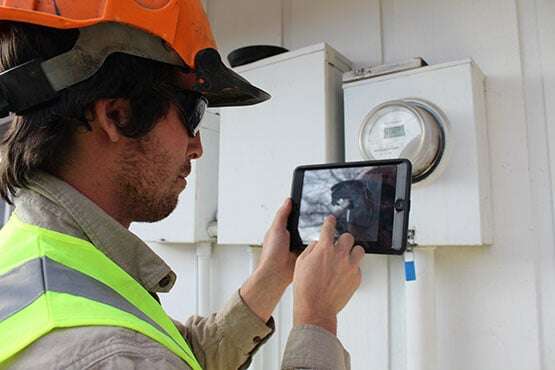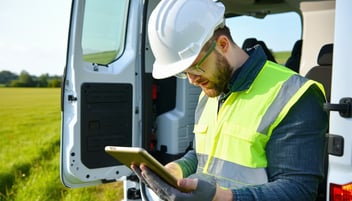
These times are unprecedented, and no one really knows what will happen tomorrow. For many utility service providers, whether providing water, electric or power, their service is essential. The work must, and will, go on.
Over the years, I’ve talked with many of our utility customers about their field operations workflows. What I’ve learned is meant to be shared with other companies in the same situation. Particularly in today’s uncertain environment, bringing some semblance of certainty can make all the difference.
When the work must get done, there are great tools and software to help everyone remain committed to the job at hand. In this particular climate, I strongly believe it is critically important to empower field technicians with a mobile app that goes where they go. Keeping track of both your remote workers and assets in real-time means you have an advantage, as well as control, over aspects of field operations you otherwise would lack visibility into.
Here are 3 digital tools to help utility service providers manage field work in challenging times.
Mobile Forms Offer a Contactless Approach to Capturing Field Data
Inherently, digital mobile forms are contactless, offering a means to keep field work going while also helping to eliminate paper-based processes. Think about how many people have to come in contact with a paper form at your organization. Is it 3, 5 or 10 people? Depending on internal processes, it can be many, especially in the highly regulated utility industry.
By digitizing paper forms, field technicians can “submit” their daily or job-based forms right from their mobile device (i.e., mobile phone or tablet) immediately after the job is completed. Moreover, the operations manager doesn’t have to be physically in the office to “receive” the forms; it’s all digital. Receiving the completed form could be automated via email or notification.
Bahamas Power and Light, a leading utility provider, leverages Field Squared automated workflows to serve some of their 100,000 customers. The utility provider uses mobile forms for specific work order types, such as connect/disconnects, meter changes, streetlight installations, repairs, inspections as well as asset-related forms. Some forms require photo capture and markup to denote issues that need to be addressed or as evidence an issue has been resolved.

As a utility services provider, do your field technicians need to take photos? How about scanning barcodes? Given the volume of pictures and barcode scans that one of our long-standing customers, National Metering, takes in the field, they integrated Dropbox via Field Squared’s out-of-the-box connector for touchless backup, as required for their record-keeping purposes. One less thing to remember to do later, since it’s all automated within Field Squared.
Save on Time, Costs and Resources with Automated Scheduling and Dispatching
Today, there is no reason why any utility company should be using spreadsheets, whiteboards or sticky notes to schedule crews to work sites. This practice 100% inefficient.
Types of utility work typically fall into three categories:
- Day to day, non-emergency work that comes in
- Emergency work orders
- Regularly scheduled recurring jobs, such as maintenance or readings
For the first two categories, dispatching crews is typically a real-time activity. Having proper software in place to manage the workload, including the workload potential, is essential for any utility provider. In this ever-changing environment, being able to quickly dispatch crews is a business-critical activity. At any given time across your field workforce, you need to know who is located where, who is available when and who has the right skills to take on a job.
When you have the right field service software, operations managers have access to route optimization tools that save utility providers on gas costs as well as time and resources. Why? Because field crews have all they need about the work order at their fingertips. If the technician runs into an issue, real-time collaboration tools embedded in the mobile app ensure help is a chat away.
Many utility customers I’ve spoken with include the following among the things they looked for in a service software when they came to Field Squared:
- Optimize field service routes in real-time by availability, location, parts, and skills
- Reduce truck rolls and minimize travel time to save on gas costs
- Coordinate different types of utility service work, including over multiple days and multiple crews
Remotely Manage and Monitor Internal or Customer-Owned Assets
The nature of utility work often involves either managing internal or customer-owned assets, while conducting work against these assets. Our customer base consists of utility service providers in both categories.
Whether utility providers conduct routine maintenance work or monitor assets, much of this work is done remotely. This is mainly guided by advancements in technology to accomplish this. When it comes to enterprise asset management, knowing where assets are located is as important as how well the asset is operating.
At a minimum, operations managers as well as field technicians should be able to use field service software to remotely:
- View all your field assets on an interactive Map
- Quickly display asset details via barcode or QR code scan
- Track asset location history over time
- See assets in proximity to a technician’s location
Many go a step further by leveraging Esri ArcGIS to enrich their utility data and provide additional GIS insights. Being able to effectively employ your ArcGIS asset database into your remote operations is what I consider to be essential in this environment. When our utility customers required it to be more efficient, we built a zero-effort integration to Esri ArcGIS from Field Squared. The ability to extend investments you’ve already made in other tools, systems and software across your entire field operations via all-in-one field service automation software like Field Squared is a game-changer.
In today’s specific environment, having asset records immediately available on the field worker’s mobile device means fewer times the worker physically needs to be touch/come in contact with assets in the field to check readings. Fewer physical interactions translates to the ability to keep surfaces clean.
For any type of asset work, technicians need the right mobile tools to enable effective remote work. Preventive maintenance, integrating IoT monitoring systems and automated range validation workflows help keep your remote workforce running smoothly during challenging times. Automation is a key method to maintain open communication 24x7x365 as is needed in the utility industry.
These 3 digital tools to help utility service providers manage field work to ensure providers can navigate this challenging time. By adopting cloud-based field service software like Field Squared today, utilities future-proof their field operations.
It’s easy to get started. Field Squared is software as a service, implemented and delivered online. Get a demo and see how we can help your utility services organization manage your remote workforce today.



